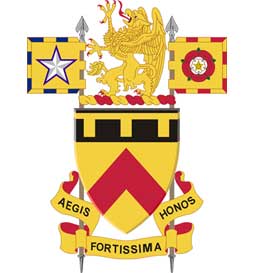

(“Honor is the strongest shield”)
Heraldry can be defined as a communication system that uses colors and symbols for the purpose of personal or organizational identification. All forms of communication are solutions created to help solve problems. In heraldry’s case, the problem was one of limited visibility. Advances in armor in the 11th and 12th Centuries provided soldiers with increased protection, including helmets that covered much of a person’s face. Without being able to see one another well enough to tell friend from foe, allies and enemies alike agreed that a system of identification was necessary in order to be effective in combat. The shield, heraldry’s most recognizable component, provided a broad, flat surface on which to paint colors and symbols assigned to a particular nobleman and his knights. Often, a nobleman also attached a cloak embroidered with his personal colors and symbols to his armor before riding into battle-a custom that gave rise to the term “a coat of arms.”
By the time a group of influential businessmen and landowners in Britain’s American colonies declared independence from the Crown in 1776, heraldry was found in every aspect of European life. Religious communities, trade guilds, city councils, and royal households all made use of heraldry, including the practice of passing down coats of arms from one generation to the next in aristocratic families. Determined to sever ties with the excesses of monarchy and the nobility, the founding fathers of the United States made sure that the honors, titles, and privileges given to Europe’s elite had no place in their young republic. Consequently, the construction of early U.S. society included a rejection of traditional heraldry.
For over a century, the U.S. Government and its armed forces would forge ahead in shaping a new nation without any real centralized authority to register, record, or regulate the design and use of federal and military symbols (called “insignia”). Eventually, President Woodrow Wilson would share his concern about the wide range of colors, shapes, and sizes that comprised U.S. military insignia in the early part of the 20th Century. In 1918, the President directed the War Department to establish an office that could organize military insignia such as metal badges, ribbons, patches, and flags. The Institute of Heraldry traces its roots back to President Wilson’s order, a task that captures the very foundation of heraldry-namely, developing a system for clear communication and identification on the battlefield.
Today, The Institute of Heraldry continues its mission to provide the highest quality heraldic services to the Federal Government, the Armed Forces, and the Office of the President. As important for the modern soldier’s success as it was for that of the medieval knight, heraldry refuses to be just another relic of feudal or imperial times of old. Heraldry is alive and well, still helping to solve the timeless problem of making identification as effective as possible
(source website The Institute of Heraldry)

